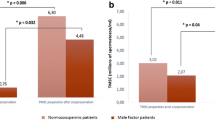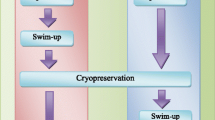Abstract
Purpose
This work was to compare the effects of Percoll gradient and swim-up treatments for sperm preparation on the percentage of progressive motility, recovery of motile sperm, removal of debris, percentage of normal forms according to strict criteria, and movement characteristics of sperm using computer-assisted velocity analysis.
Results
In total, 50 semen samples from 50 patients were tested and divided into two groups: a normal group (n=27) with normal parameters and an abnormal group (n=23) with abnormal parameters. The results in both the normal and the abnormal groups revealed that the sperm concentration in the Percoll samples was significantly greater than that in the swim-up samples. Although the percentage of progressive motility was greater in the swim-up samples than in the Percoll samples, the number of motile sperm, reflecting the percentage of motile sperm recovery, was still greater in the Percoll samples. The debris of semen were equally removed by both methods and the percentage of normal forms was also similar in the samples treated according to these two procedures. Both curvilinear velocity (VCL) and straight-line velocity (VSL) of sperm were significantly greater in the swim-up samples than in the Percoll samples. Sperm from the swim-up procedure also showed a greater mean amplitude of lateral head displacement than that from the Percoll gradient procedure, but the distinction was insignificant.
Conclusion
The Percoll gradient technique, by recovering more motile sperm, may be applied to prepare oligospermic samples. The swim-up method may become the standard choice to prepare normal semen which could obtain sufficiently motile sperm, due to its simplicity and recovered sperm with superior motility.
Similar content being viewed by others
References
Tsaur GT, Lien YR, Yang YS: Artificial insemination: Intracervical versus intrauterine insemination by “swim-up” sperm preparation. J Obstet Gynecol ROC 1990;29:211–220
Yang YS, Ho HN, Lien YR, Lin HR, Hsieh CY, Lee TY: Treatment of patients with unexplained infertility: Gamete intrafallopian transfer (GIFT) versus tubal embryo transfer (TET). J Formosan Med Assoc 1990;90:547–550
Yang YS, Melinda S, Ho HN, Hwang JL, Chen SU, Lin HR, Huang SC, Lee TY: Effect of the number and the depth of embryos transferred and unilateral or bilateral transfer in tubal embryo transfer (TET). J Assist Reprod Genet 1992;9:534–538
Siegel MS: The male fertility investigation and the role of the andrology laboratory. J Reprod Med 1993;38:317–334
Lopata A, Patullo MJ, Chang A, James B: A method for collecting motile spermatozoa from human semen. Fertil Steril 1976;27:677–684
Paulson JD, Polakoski KL: A glass wool column procedure for removing extraneous material from the human ejaculate. Fertil Steril 1977;28:178–181
Gorus FK, Pipeleers DG: A rapid method for the fractionation of human spermatozoa according to their progressive motility. Fertil Steril 1981;35:662–665
Forster MS, Smith WD, Lee WI, Berger RE, Karp LE, Stenchever MA: Selection of human spermatozoa according to their relative motility and their interaction with zona-free hamster eggs. Fertil Steril 1983;40:655–660
Ericsson RJ: Isolation and storage of progressively motile human sperm. Andrologia 1977;9:11–15
Lin MC, Chen CJ, Yang YS, Tsai T: A new method for recovery of motile sperm using osmolarity-gradient technique. Arch Androl 1991;27:177–184
Akerlof E, Fredricson B, Gustafsson O, Lundin A, Lunell NO, Nylund L, Rosenborg L, Pousette A: Comparison between a swim-up and a Percoll gradient technique for the separation of human spermatozoa. Int J Androl 1987;10:663–669
Van der Zwalmen P, Bertin-Segal G, Geerts L, Debauche C, Schoysman R: Sperm morphology and IVF pregnancy rate: Comparison between Percoll gradient centrifugation and swim-up procedures. Hum Reprodu 1991;6:581–588
Guerin JF, Mathieu C, Lornage J, Pinatel MC, Boulieu D: Improvement of survival and fertilizing capacity of human spermatozoa in an IVF programme by selection on discontinuous Percoll gradients. Hum Reprod 1989;4:798–804
Pardo M, Buxaderas C, Barri PN, Pomerol JM, Bancells N, Sabater J, Coroleu B: Spermatozoa selection in discontinuous Percoll gradients for use in artificial insemination. Fertil Steril 1988;49:505–509
Ng FL, Liu DY, Baker HW: Comparison of Percoll, mini-Percoll and swim-up methods for sperm preparation from abnormal semen samples. Hum Reprod 1992;7:261–266
Englert Y, Van den Bergh M, Rodesch C, Bertrand E, Biramane J, Legreve A: Comparative auto-controlled study between swim-up and Percoll preparation of fresh semen samples for in-vitro fertilization. Hum Reprod 1992;7:399–402
Hyne RV, Stojanoff A, Clarke GN, Lopata A, Johnston WIH: Pregnancy from in vitro fertilization of human eggs after separation of motile spermatozoa by density gradient centrifugation. Fertil Steril 1986;45:93–96
Berger T, Marrs RP, Moyer DL: Comparison of techniques for selection of motile spermatozoa. Fertil Steril 1985;43:268–273
Morales P, Vantman D, Barros C, Vigil P: Human spermatozoa selected by Percoll gradient or swim-up are equally capable of binding to the human zona pellucida and under-going the acrosome reaction. Hum Reprod 1991;6:401–404
Kruger TF, Swanson RJ, Acosta AA, Matta JF, Simmons KF, Oehninger S: Predictive value of abnormal sperm morphology in in vitro fertilization. Fertil Steril 1988;49:112–117
Holt WV, Moore HDM, Hillier SG: Computer-assisted measurement of sperm swimming speed in human semen: Correlation of results with in vitro fertilization assays. Fertil Steril 1985;44:112–119
Chu GP, Yang YS, Chen SU, Ho HN, Chen HF, Lin HR, Huang SU, Lee TY: The correlation between in vitro fertilization and sperm motility assessed by computer-assisted semen analyzer (CASA). J Reprod Infertil 1993;2:10–17
World Health Organization: WHO Laboratory Manual for the Examination of Human Semen and Semen-Cervical Mucus Interaction. Cambridge, Cambridge University Press, 1992
Quinn P, Kerin JF, Warness GM: Improved pregnancy rate in human in vitro fertilization with the use of a medium based on the composition of human tubal fluid. Fertil Steril 1985;44:493–498
McClure RD, Nunes L, and Tom R: Semen manipulation: Improved sperm recovery function with a two-layer Percoll gradient. Fertil Steril 1989;51:874–877
Chan SY, Chan YM, Tucker MJ: Comparison of characteristics of human spermatozoa selected by the multiple-tube swim-up and simple discontinuous Percoll gradient centrifugation. Andrologia 1991;23:213–218
Menkveld R, Swanson RJ, Kotze TJ, Kruger TF: Comparison of a discontinuous Percoll gradient method versus a swim-up method: Effects on sperm morphology and other semen parameters. Andrologia 1990;22:152–158
Lannou DL, Blanchard Y: Nuclear maturity and morphology of human spermatozoa selected by Percoll density gradient centrifugation or swim-up procedure. J Reprod Fertil 1988;84:551–556
Marshburn PB, Mclntire D, Carr BR, Byrd W: Spermatozoal characteristics from fresh and frozen donor semen and their correlation with fertility outcome after insemination. Fertil Steril 1992;58:179–186
Lalich RA, Marut EL, Prins GS, Scommegna A: Life table analysis of intrauterine insemination pregnancy rates. Am J Obstet Gynecol 1988;158:980–984
Author information
Authors and Affiliations
Rights and permissions
About this article
Cite this article
Chen, SU., Ho, HN., Chen, HF. et al. Comparison between a two-layer discontinuous Percoll gradient and swim-up for sperm preparation on normal and abnormal semen samples. J Assist Reprod Genet 12, 698–703 (1995). https://doi.org/10.1007/BF02212896
Received:
Accepted:
Issue Date:
DOI: https://doi.org/10.1007/BF02212896




